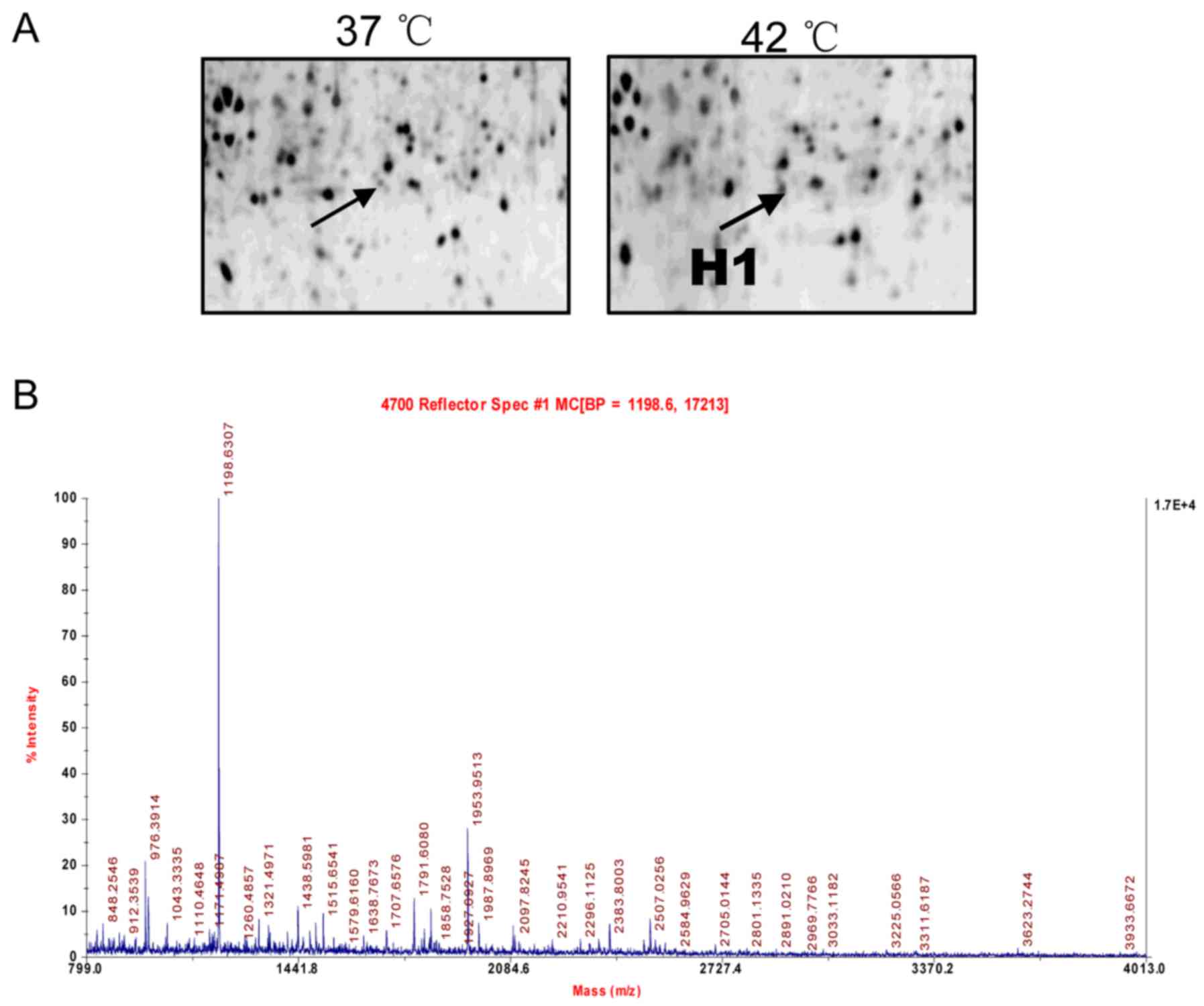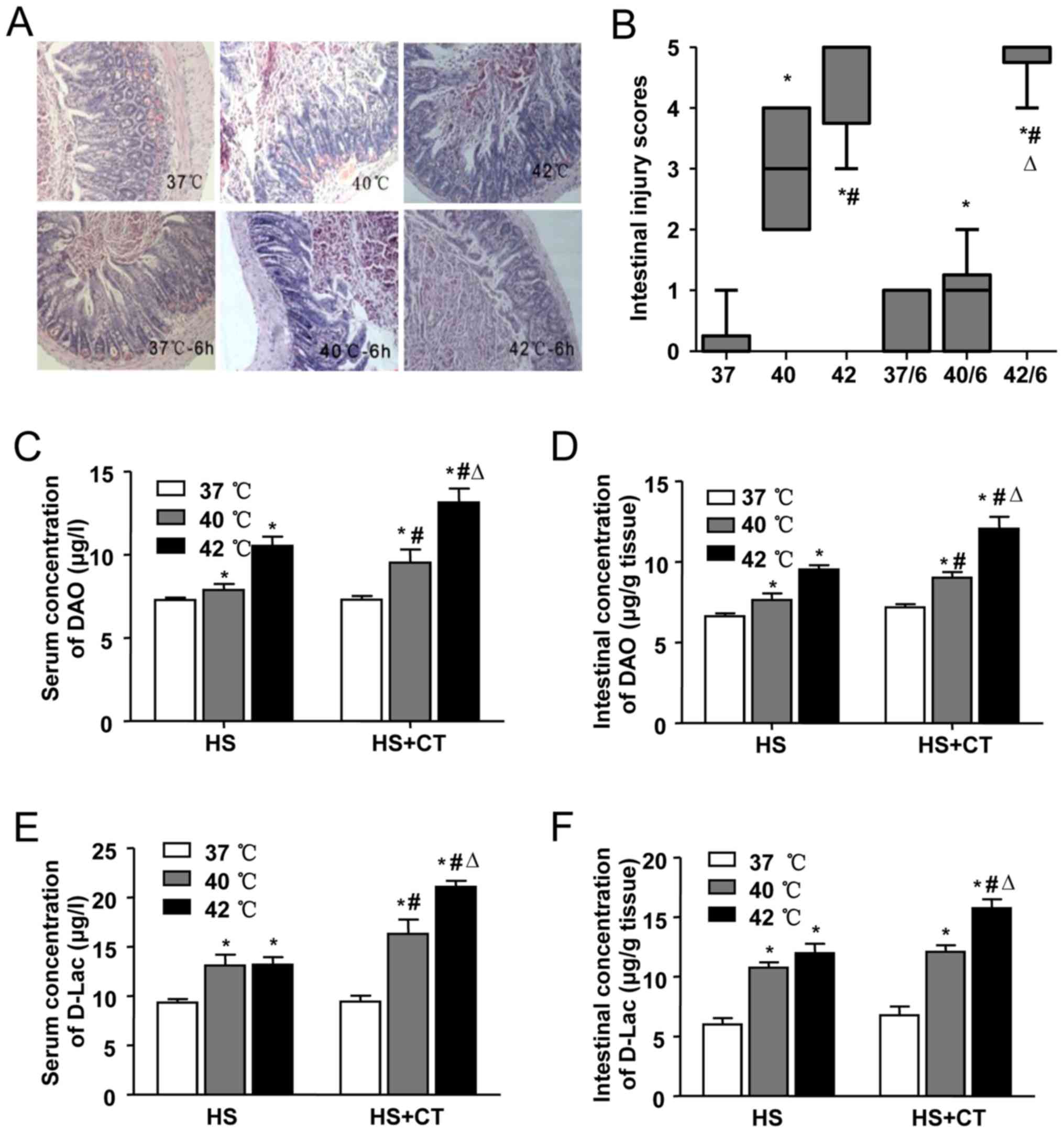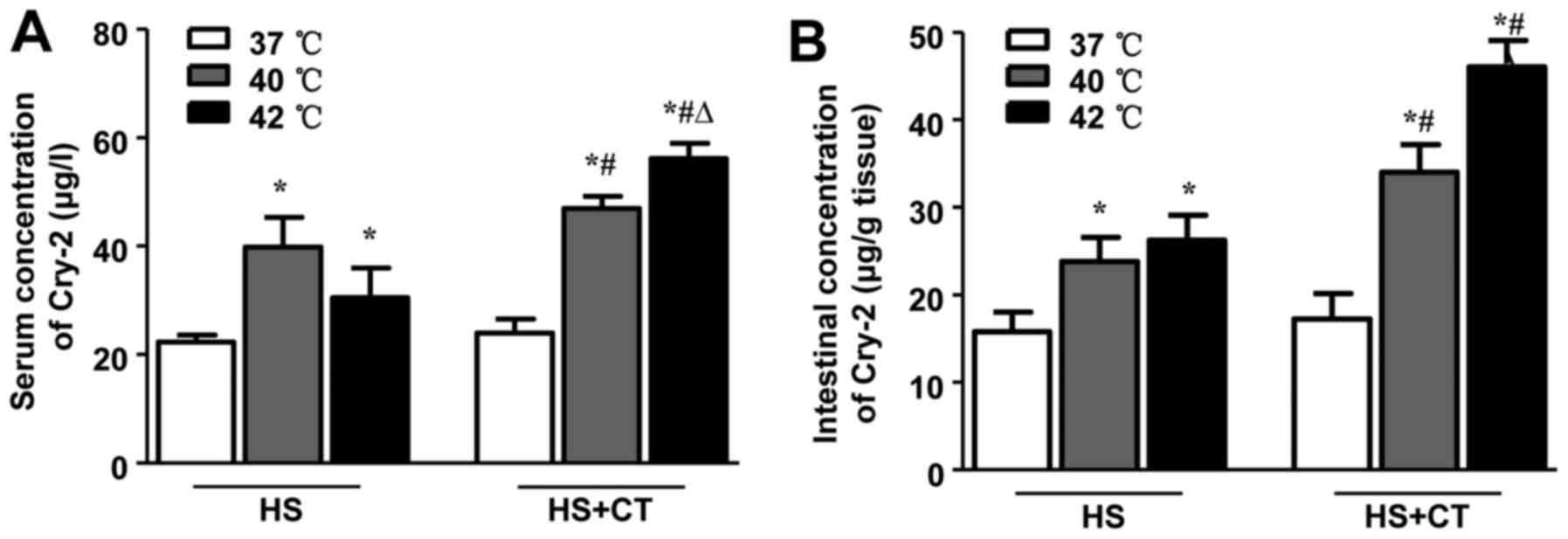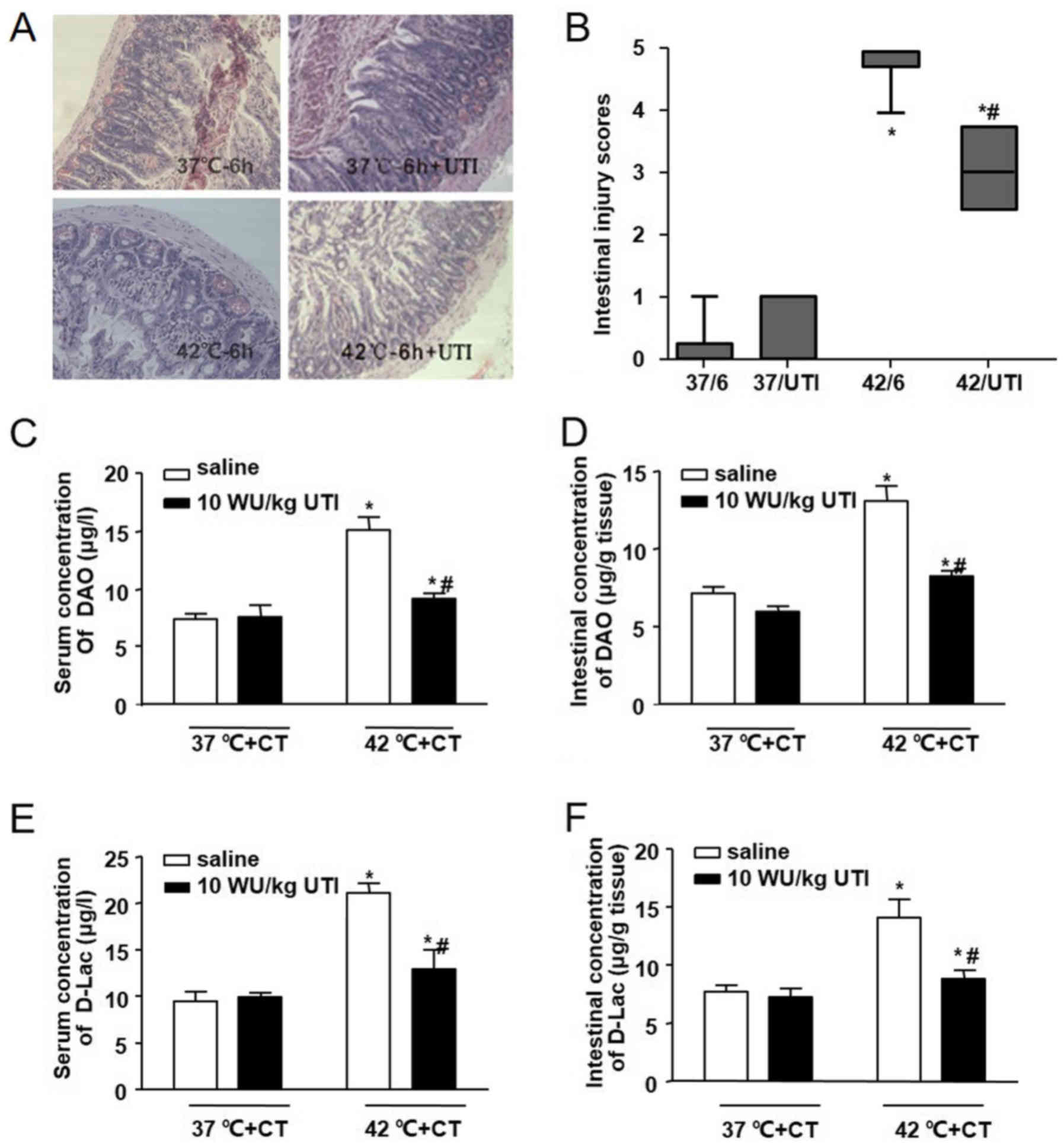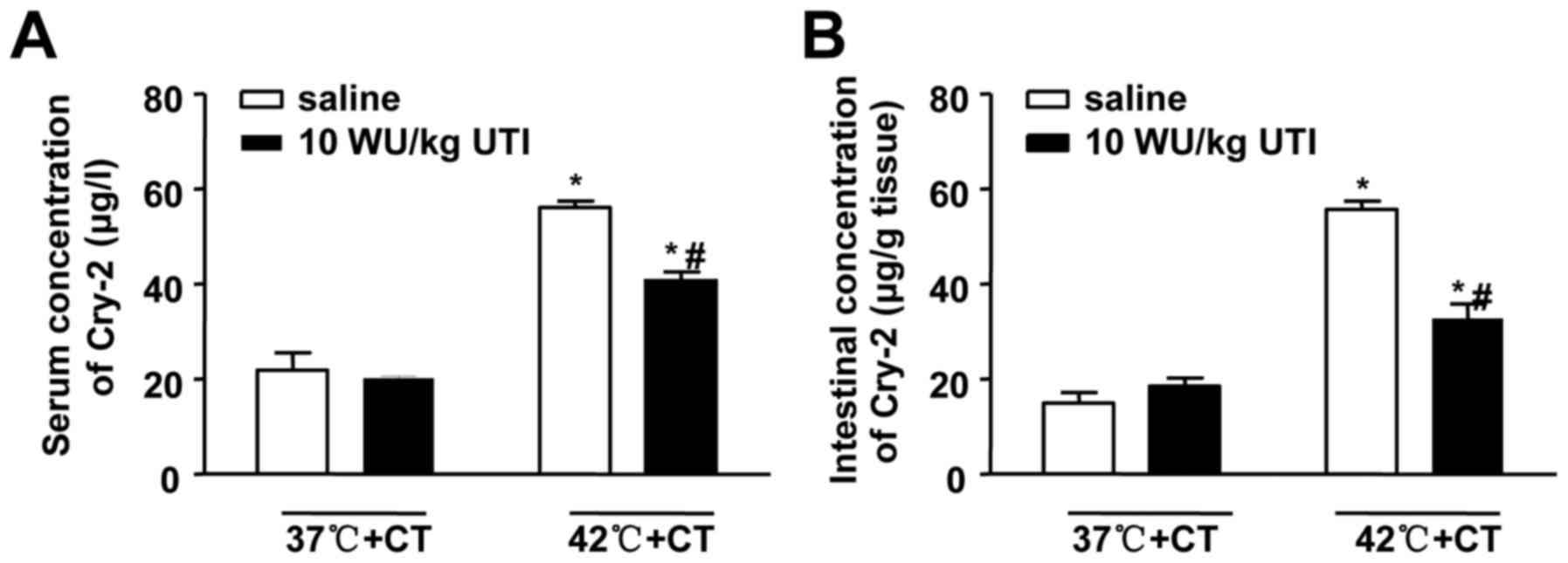|
1
|
Leon LR and Bouchama A: Heat stroke. Compr
Physiol. 5:611–647. 2015. View Article : Google Scholar : PubMed/NCBI
|
|
2
|
Sucholeiki R: Heatstroke. Semin Neurol.
25:307–314. 2005. View Article : Google Scholar : PubMed/NCBI
|
|
3
|
Lambert GP, Gisolfi CV, Berg DJ, Moseley
PL, Oberley LW and Kregel KC: Selected contribution:
Hyperthermia-induced intestinal permeability and the role of
oxidative and nitrosative stress. J Appl Physiol. 1985.
92:1750–1761; discussion 1749. 2002. View Article : Google Scholar : PubMed/NCBI
|
|
4
|
Yang P-C, He S-H and Zheng P-Y:
Investigation into the signal transduction pathway via which heat
stress impairs intestinal epithelial barrier function. J
Gastroenterol Hepatol. 22:1823–1831. 2007. View Article : Google Scholar : PubMed/NCBI
|
|
5
|
Liu Z, Liu JH, Liu Y, Tang Y, Meng F, Sun
X, Tang J, Wang JH and Su L: Proteomic analysis and identification
of intestinal FBP as a predictor of gut dysfunction during
heatstroke in mice. J Surg Res. 173:332–340. 2012. View Article : Google Scholar
|
|
6
|
Ouellette AJ, Hsieh MM, Nosek MT,
Cano-Gauci DF, Huttner KM, Buick RN and Selsted ME: Mouse Paneth
cell defensins: Primary structures and antibacterial activities of
numerous cryptdin isoforms. Infect Immun. 62:5040–5047.
1994.PubMed/NCBI
|
|
7
|
Ouellette AJ, Satchell DP, Hsieh MM, Hagen
SJ and Selsted ME: Characterization of luminal paneth cell
alpha-defensins in mouse small intestine. Attenuated antimicrobial
activities of peptides with truncated amino termini. J Biol Chem.
275:33969–33973. 2000. View Article : Google Scholar : PubMed/NCBI
|
|
8
|
Preet S, Verma I and Rishi P: Cryptdin-2:
A novel therapeutic agent for experimental Salmonella typhimurium
infection. J Antimicrob Chemother. 65:991–994. 2010. View Article : Google Scholar : PubMed/NCBI
|
|
9
|
Singh AP, Prabha V and Rishi P: Efficacy
of cryptdin-2 as an adjunct to antibiotics from various generations
against Salmonella. Indian J Microbiol. 54:323–328. 2014.
View Article : Google Scholar : PubMed/NCBI
|
|
10
|
Inoue R, Tsuruta T, Nojima I, Nakayama K,
Tsukahara T and Yajima T: Postnatal changes in the expression of
genes for cryptdins 1-6 and the role of luminal bacteria in
cryptdin gene expression in mouse small intestine. FEMS Immunol Med
Microbiol. 52:407–416. 2008. View Article : Google Scholar : PubMed/NCBI
|
|
11
|
Shi J, Aono S, Lu W, Ouellette AJ, Hu X,
Ji Y, Wang L, Lenz S, van Ginkel FW, Liles M, et al: A novel role
for defensins in intestinal homeostasis: Regulation of IL-1beta
secretion. J Immunol. 179:1245–1253. 2007. View Article : Google Scholar : PubMed/NCBI
|
|
12
|
Lee HT, Kim M, Kim JY, Brown KM, Ham A,
D'Agati VD and Mori-Akiyama Y: Critical role of interleukin-17A in
murine intestinal ischemia-reperfusion injury. Am J Physiol
Gastrointest Liver Physiol. 304:G12–G25. 2013. View Article : Google Scholar
|
|
13
|
Miyoshi J, Miyamoto H, Goji T, Taniguchi
T, Tomonari T, Sogabe M, Kimura T, Kitamura S, Okamoto K, Fujino Y,
et al: Serum diamine oxidase activity as a predictor of
gastrointestinal toxicity and malnutrition due to anticancer drugs.
J Gastroenterol Hepatol. 30:1582–1590. 2015. View Article : Google Scholar : PubMed/NCBI
|
|
14
|
Tan S, Yokoyama Y, Dickens E, Cash TG,
Freeman BA and Parks DA: Xanthine oxidase activity in the
circulation of rats following hemorrhagic shock. Free Radic Biol
Med. 15:407–414. 1993. View Article : Google Scholar : PubMed/NCBI
|
|
15
|
Demircan M, Cetin S, Uguralp S, Sezgin N,
Karaman A and Gozukara EM: Plasma D-lactic acid level: A useful
marker to distinguish perforated from acute simple appendicitis.
Asian J Surg. 27:303–305. 2004. View Article : Google Scholar : PubMed/NCBI
|
|
16
|
Smith SM, Eng RH and Buccini F: Use of
D-lactic acid measurements in the diagnosis of bacterial
infections. J Infect Dis. 154:658–664. 1986. View Article : Google Scholar : PubMed/NCBI
|
|
17
|
Chen X, Wang Y, Luo H, Luo Z, Liu L, Xu W,
Zhang T, Yang N, Long X, Zhu N, et al: Ulinastatin reduces urinary
sepsis related inflammation by upregulating IL-10 and
downregulating TNF-α levels. Mol Med Rep. 8:29–34. 2013. View Article : Google Scholar : PubMed/NCBI
|
|
18
|
Wang SY, Li ZJ, Wang X, Li WF and Lin ZF:
Effect of ulinastatin on HMGB1 expression in rats with acute lung
injury induced by sepsis. Genet Mol Res. 14:4344–4353. 2015.
View Article : Google Scholar : PubMed/NCBI
|
|
19
|
Nakatani K, Takeshita S, Tsujimoto H,
Kawamura Y and Sekine I: Inhibitory effect of serine protease
inhibitors on neutrophil-mediated endothelial cell injury. J Leukoc
Biol. 69:241–247. 2001.PubMed/NCBI
|
|
20
|
Xu CE, Zhang MY, Zou CW and Guo L:
Evaluation of the pharmacological function of ulinastatin in
experimental animals. Molecules. 17:9070–9080. 2012. View Article : Google Scholar : PubMed/NCBI
|
|
21
|
Li C, Ma D, Chen M, Zhang L, Zhang L,
Zhang J, Qu X and Wang C: Ulinastatin attenuates LPS-induced human
endothelial cells oxidative damage through suppressing JNK/c-Jun
signaling pathway. Biochem Biophys Res Commun. 474:572–578. 2016.
View Article : Google Scholar : PubMed/NCBI
|
|
22
|
Feng C, Li B, Wang LL, Chen LI, Zhou X, Lv
FQ and Li TS: Effect of peritoneal lavage with ulinastatin on the
expression of NF-κB and TNF-α in multiple organs of rats with
severe acute pancreatitis. Exp Ther Med. 10:2029–2034. 2015.
View Article : Google Scholar : PubMed/NCBI
|
|
23
|
Atal SS and Atal S: Ulinastatin - a newer
potential therapeutic option for multiple organ dysfunction
syndrome. J Basic Clin Physiol Pharmacol. 27:91–99. 2016.
View Article : Google Scholar
|
|
24
|
Zhou G, Xu Q, Liu Y, Wang Z, Su L and Guo
X: Protective effects of ulinastatin against acute lung injury
induced by heatstroke in mice. Nan Fang Yi Ke Da Xue Xue Bao.
35:1277–1282. 2015.In Chinese. PubMed/NCBI
|
|
25
|
Liu Z, Sun X, Tang J, Tang Y, Tong H, Wen
Q, Liu Y and Su L: Intestinal inflammation and tissue injury in
response to heat stress and cooling treatment in mice. Mol Med Rep.
4:437–443. 2011.PubMed/NCBI
|
|
26
|
Chiu CJ, McArdle AH, Brown R, Scott HJ and
Gurd FN: Intestinal mucosal lesion in low-flow states. I. A
morphological, hemodynamic, and metabolic reappraisal. Arch Surg.
101:478–483. 1970. View Article : Google Scholar : PubMed/NCBI
|
|
27
|
Livak KJ and Schmittgen TD: Analysis of
relative gene expression data using real-time quantitative PCR and
the 2(-Delta Delta C(T)) method. Methods. 25:402–408. 2001.
View Article : Google Scholar
|
|
28
|
Rahman A, Fahlgren A, Sundstedt C,
Hammarström S, Danielsson A and Hammarström ML: Chronic colitis
induces expression of β-defensins in murine intestinal epithelial
cells. Clin Exp Immunol. 163:123–130. 2011. View Article : Google Scholar :
|
|
29
|
Gathiram P, Wells MT, Raidoo D, Brock-Utne
JG and Gaffin SL: Portal and systemic plasma lipopolysaccharide
concentrations in heat-stressed primates. Circ Shock. 25:223–230.
1988.PubMed/NCBI
|
|
30
|
Tang J, Jiang Y, Tang Y, Chen B, Sun X, Su
L and Liu Z: Effects of propofol on damage of rat intestinal
epithelial cells induced by heat stress and lipopolysaccharides.
Braz J Med Biol Res. 46:507–512. 2013. View Article : Google Scholar : PubMed/NCBI
|
|
31
|
Liu Y, Zhou G, Wang Z, Guo X, Xu Q, Huang
Q and Su L: NF-κB signaling is essential for resistance to heat
stress-induced early stage apoptosis in human umbilical vein
endothelial cells. Sci Rep. 5:135472015. View Article : Google Scholar
|
|
32
|
Hall DM, Baumgardner KR, Oberley TD and
Gisolfi CV: Splanchnic tissues undergo hypoxic stress during whole
body hyperthermia. Am J Physiol. 276:G1195–G1203. 1999.PubMed/NCBI
|
|
33
|
Yin P, Xu J, He S, Liu F, Yin J, Wan C,
Mei C, Yin Y, Xu X and Xia Z: Endoplasmic reticulum stress in heat-
and shake-induced injury in the rat small intestine. PLoS One.
10:e01439222015. View Article : Google Scholar : PubMed/NCBI
|
|
34
|
Johnson JS, Sapkota A and Lay DC Jr: Rapid
cooling after acute hyperthermia alters intestinal morphology and
increases the systemic inflammatory response in pigs. J Appl
Physiol. 120:1249–1259. 2016. View Article : Google Scholar
|
|
35
|
Starkie RL, Hargreaves M, Rolland J and
Febbraio MA: Heat stress, cytokines, and the immune response to
exercise. Brain Behav Immun. 19:404–412. 2005. View Article : Google Scholar : PubMed/NCBI
|
|
36
|
Welc SS, Judge AR and Clanton TL: Skeletal
muscle interleukin-6 regulation in hyperthermia. Am J Physiol Cell
Physiol. 305:C406–C413. 2013. View Article : Google Scholar : PubMed/NCBI
|
|
37
|
Dupont A, Heinbockel L, Brandenburg K and
Hornef MW: Antimicrobial peptides and the enteric mucus layer act
in concert to protect the intestinal mucosa. Gut Microbes.
5:761–765. 2014. View Article : Google Scholar : PubMed/NCBI
|
|
38
|
Ayabe T, Satchell DP, Wilson CL, Parks WC,
Selsted ME and Ouellette AJ: Secretion of microbicidal
alpha-defensins by intestinal Paneth cells in response to bacteria.
Nat Immunol. 1:113–118. 2000. View
Article : Google Scholar
|
|
39
|
Wehkamp J, Schmid M and Stange EF:
Defensins and other antimicrobial peptides in inflammatory bowel
disease. Curr Opin Gastroenterol. 23:370–378. 2007. View Article : Google Scholar : PubMed/NCBI
|
|
40
|
Mastroianni JR and Ouellette AJ:
Alpha-defensins in enteric innate immunity: Functional Paneth cell
alpha-defensins in mouse colonic lumen. J Biol Chem.
284:27848–27856. 2009. View Article : Google Scholar : PubMed/NCBI
|
|
41
|
Mattar EH, Almehdar HA, Yacoub HA, Uversky
VN and Redwan EM: Antimicrobial potentials and structural disorder
of human and animal defensins. Cytokine Growth Factor Rev.
28:95–111. 2016. View Article : Google Scholar
|
|
42
|
Zhang C, Wang Y, Fu W, Zhang W, Wang T and
Qin H: A meta-analysis on the effect of ulinastatin on serum levels
of C-reactive protein, interleukin 6, and tumor necrosis factor
alpha in Asian patients with acute pancreatitis. Genet Test Mol
Biomarkers. 20:118–124. 2016. View Article : Google Scholar : PubMed/NCBI
|
|
43
|
Huang Y, Xie K, Zhang J, Dang Y and Qiong
Z: Prospective clinical and experimental studies on the
cardioprotective effect of ulinastatin following severe burns.
Burns. 34:674–680. 2008. View Article : Google Scholar : PubMed/NCBI
|
|
44
|
Masuda T, Sato K, Noda C, Ikeda KM,
Matsunaga A, Ogura MN, Shimizu K, Nagasawa H, Matsuyama N and Izumi
T: Protective effect of urinary trypsin inhibitor on myocardial
mitochondria during hemorrhagic shock and reperfusion. Crit Care
Med. 31:1987–1992. 2003. View Article : Google Scholar : PubMed/NCBI
|
|
45
|
Wang LZ, Luo MY, Zhang JS, Ge FG, Chen JL
and Zheng CQ: Effect of ulinastatin on serum inflammatory factors
in Asian patients with acute pancreatitis before and after
treatment: A meta-analysis. Int J Clin Pharmacol Ther. 54:890–898.
2016. View Article : Google Scholar : PubMed/NCBI
|
|
46
|
Wang L, Huang X, Kong G, Xu H, Li J, Hao
D, Wang T, Han S, Han C, Sun Y, et al: Ulinastatin attenuates
pulmonary endothelial glycocalyx damage and inhibits endothelial
heparanase activity in LPS-induced ARDS. Biochem Biophys Res
Commun. 478:669–675. 2016. View Article : Google Scholar : PubMed/NCBI
|
|
47
|
Lin B, Liu Y, Li T, Zeng K, Cai S, Zeng Z,
Lin C, Chen Z and Gao Y: Ulinastatin mediates protection against
vascular hyperpermeability following hemorrhagic shock. Int J Clin
Exp Pathol. 8:7685–7693. 2015.PubMed/NCBI
|
|
48
|
Kato Y, Kudo M, Shinkawa T, Mochizuki H,
Isaji M, Shiromizu I and Hoshida K: Role of O-linked carbohydrate
of human urinary trypsin inhibitor on its lysosomal
membrane-stabilizing property. Biochem Biophys Res Commun.
243:377–383. 1998. View Article : Google Scholar : PubMed/NCBI
|
|
49
|
Lehrer RI: Multispecific myeloid
defensins. Curr Opin Hematol. 14:16–21. 2007. View Article : Google Scholar
|
|
50
|
Gao C, Li R and Wang S: Ulinastatin
protects pulmonary tissues from lipopolysaccharide-induced injury
as an immunomodulator. J Trauma Acute Care Surg. 72:169–176.
2012.
|
|
51
|
Kobayashi KS, Chamaillard M, Ogura Y,
Henegariu O, Inohara N, Nuñez G and Flavell RA: Nod2-dependent
regulation of innate and adaptive immunity in the intestinal tract.
Science. 307:731–734. 2005. View Article : Google Scholar : PubMed/NCBI
|















